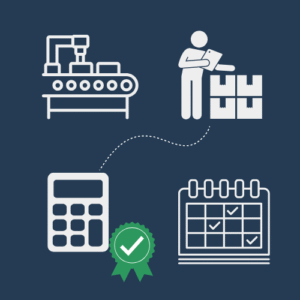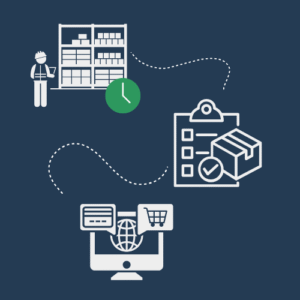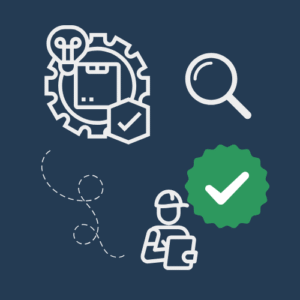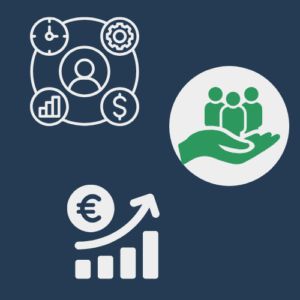Everything you need to know about SAP Business Suite: how it works, definition
You are here : Home " SAP Guide " SAP Solutions "SAP Business Suite
SAP Business Suite is an integrated set of ERP applications designed to help companies manage all their business processes, from finance and logistics to customer relations, purchasing and production.
It's a robust software suite used by thousands of organizations worldwide to manage their operations smoothly, centrally and consistently.
But beware: SAP Business Suite is not a single product, but a complete ecosystem. An ERP base combined with several business applications, with interconnected modules, cross-functional features and a structure designed for medium-sized to very large companies.
It's also a solution in full transformation.
With the arrival of SAP S/4HANA, SAP Business Suite is entering a phase of strategic transition. Some companies are staying with Business Suite 7, while others are migrating to new, more modern, cloud-native architectures, driven by real-time data.
Application overview
SAP Business Suite is not a single application, but a coherent set of ERP solutions designed to cover all a company's key processes.
The idea? Provide a unified view of the business, centralize data and automate critical tasks across the entire operational cycle.
A modular suite, built for large companies
SAP Business Suite brings together several of SAP's flagship products, each specialized in a particular business area:
SAP ERP
the heart of the system, dedicated to financial management, logistics, HR, production, etc.
SAP CRM
for customer relationship management, from marketing to after-sales.
SAP SRM
for purchasing, supplier management and procurement.
nement.
SAP SCM
for supply chain planning.
SAP PLM
for product lifecycle management.
Each of these components can operate independently, but their full power is realized when integrated with the others. This is where the promise of SAP Business Suite lies: seamless, cross-functional management of business processes.
A proven technology base
Historically, SAP Business Suite is based on SAP NetWeaver. It enables the various modules to be interconnected and adapted to the specific needs of each company.
Today, the most widespread version remains SAP Business Suite 7, which continues to be supported (with extended maintenance) for companies that have not yet migrated to S/4HANA.
What's the link between SAP Business Suite and SAP HANA?
For a long time, SAP Business Suite was based on classic databases such as Oracle or IBM DB2.
But everything changed with the arrival of SAP HANA.
SAP HANA is the in-memory database developed by SAP. It's ultra-fast, designed for real time, and capable of processing both transactions (OLTP) and analyses (OLAP) on a single platform.
SAP Business Suite powered by HANA
SAP has gradually enabled companies to run their Business Suite on SAP HANA, without changing the application architecture.
This is often referred to as SAP Business Suite powered by SAP HANA.
In concrete terms, this means that :
- the data is stored in SAP HANA,
- treatments are accelerated,
- reports are produced in real time,
- overall performance is greatly improved.
But be warned: we're not talking about S/4HANA yet.
S/4HANA: the new generation
S/4HANA is the complete rewrite of SAP Business Suite, designed natively for SAP HANA, with a new interface (Fiori), a simplified data model and cloud-first logic.
This is the next step for companies wishing to go beyond the simple "lift & shift" of the database.
SAP HANA is therefore not a competitor, but a an engine of transformation for SAP Business Suite users.
This is what enables traditional ERP systems to enter the era of real-time, data-driven decision-making.
Technical features and architecture
SAP Business Suite is based on a modular, robust and highly integrated architecture. Its objective: to guarantee the consistency of business processes on a large scale, while adapting to the specific needs of each organization.
A multi-layer architecture
The architecture of SAP Business Suite follows a classic three-tier model:
- Database Where all information (finance, stock, orders, etc.) is stored.
- Application server Logic engine that executes business rules, processing flows and calls between modules.
- User interface Access via SAP GUI, web portal or Fiori applications (in HANA versions).
This decoupling separates technical responsibilities and optimizes performance, security and scalability.
Native module integration
The great strength of SAP Business Suite is its native integration between functional areas. For example :
- A sales order (SD module) automatically generates an accounting entry (FI module).
- A purchase requirement triggered in production (module PP) generates a procurement request (module MM).
Everything is interconnected, eliminating the need to re-enter data and synchronization errors. complete traceability from start to finish.
Customization and specific development
Every company has its own processes.
SAP Business Suite enables :
- parameterize standard processes,
- add specific business rules,
- develop extensions via ABAP (SAP's proprietary language),
- integrate third-party solutions via middleware (e.g. SAP PI/PO or SAP Cloud Integration).
In short, SAP Business Suite is a flexible, powerful ERP infrastructureWe have the ability to adapt to complex, multi-site and multi-country business environments.
The main modules of the solution
SAP Business Suite is made up of a set of functional modules, each covering a key area of business activity.
The aim is to offer a centralized solution to control the entire management cycle.
Here are the main modules used in SAP Business Suite :
SAP FI - Finance
Enables accounting and financial management: general accounting, accounts receivable/payable, fixed assets, cash management, monthly closing.
Indispensable for monitoring your company's financial health.
SAP CO - Controlling
Works with FI to analyze profitability, track costs, manage cost centers and profit centers.
Useful for finance departments, controllers and business analysts.
SAP MM - Purchasing
Manages procurement, purchase requisitions, supplier orders, inventories, goods receipts.
Key to optimizing the inbound logistics chain.
SAP SD - Sales and distribution
Manages quotations, sales orders, deliveries, invoicing and returns.
Useful for structuring the entire Order-to-Cash process.
SAP PP - Production planning
Allows you to plan production, manage bills of materials, production orders and component requirements.
Essential for industrial companies.
SAP HR / HCM - Human Resources
Manages personnel data, payroll, absences, training plans and appraisals.
Useful for digitizing the HR function.
SAP CRM, SCM, SRM, PLM
CRM Customer relationship management (sales, marketing, support).
SCM advanced supply chain management.
SRM Strategic supplier management.
PLM Product lifecycle management.
Each module can be activated, configured and integrated according to specific business needs.
It is this modular granularity that is the strength of SAP Business Suite in complex environments.
Good implementation practices
Implementing SAP Business Suite isn't just about installing software.
It means transforming the company's business processes in depth.
And a poorly thought-out implementation can quickly become a drain on time, budget... and human energy.
Here are the key best practices for a successful project.
Successful implementation means smooth production start-up, system adoption and real process improvements.
A multi-sector solution
One of the great strengths of SAP Business Suite is its ability to adapt to a multitude of business sectors.
Unlike some vertical ERP solutions, Business Suite offers a modular, configurable approach that makes it relevant in a wide variety of environments.

- Production management (PP), inventory management (MM), supply management (SRM)
- Monitoring quality, production costs and product bills of materials
- Integration with planning (SCM) and product lifecycle management (PLM)

- Real-time inventory optimization
- Multi-channel order management (SD)
- Interfaces with POS and e-commerce systems

- Budgeting, cost accounting, grants management
- Specific modules for government agencies, hospitals and universities

- Regulatory traceability
- Batch and campaign management
- Certification follow-up, advanced quality control

- Project management (PS), time sheets, fixed-price invoicing
- Monitoring of human resources (HCM) and profitability by mission
SAP Business Suite is not limited to any one sector or type of company.
It's an adaptable business management platform, which can be deployed as easily in an ambitious SME as in a large international group.
What changes between SAP Business Suite and SAP Business Suite 7?
When we talk about SAP Business Suite, we often think of SAP Business Suite 7, the best-known and most widely used version to date.
But what's the difference between the suite as a whole... and this particular version?
SAP Business Suite: a global framework
This is the name of SAP's ERP ecosystem, which brings together the major modules professions (FI, CO, SD, MM, etc.) and solutions such as CRM, SRM or SCM.
This term therefore refers to the complete family of applications designed to control all aspects of the business.
SAP Business Suite 7: a special version
SAP Business Suite 7 is the seventh generation of this suite. It introduces :
- better integration between components,
- enhanced business functionalities,
- and, above all, the ability to run on SAP HANA.
It was this version that served as the springboard to SAP S/4HANA, the next-generation ERP designed for the cloud and real-time data.
An extended life cycle
SAP has announced extended support for SAP Business Suite 7 until 2027 (or even 2030 under extended maintenance).
This gives companies time to plan their transition to S/4HANA, while maintaining a stable and widely-proven solution.
In a nutshell: SAP Business Suite is the generic name, while SAP Business Suite 7 refers to a specific, robust version that is still widely deployed in large enterprises.
What are the advantages and disadvantages of this solution?
Like any large-scale information system, SAP Business Suite is neither a miracle tool, nor a trivial choice.
It's a powerful solution, but one that needs to be understood, adapted... and properly managed.
SAP Business Suite remains a safe bet for companies looking for a comprehensive, modular and robust ERP solution.
But it must be deployed rigorously... and integrated into a long-term strategy.
How to learn SAP Business Suite
SAP Business Suite is a powerful solution... but it's also dense.
To understand it properly, you need more than a manual: you need a structured approach, concrete case studies, and a real business logic.
For beginners or profiles undergoing retraining
The first step is to understand general architecture of the suite modules, data flows, transactional logic.
We recommend starting with :
a SAP ERP training generalist,
then specialize in a particular key module (FI, MM, SD, etc.).
Some platforms offer certification coursesothers short, targeted training courses.
For working professionals
The first step is to understand general architecture of the suite modules, data flows, transactional logic.
We recommend starting with :
a SAP ERP training generalist,
then specialize in a particular key module (FI, MM, SD, etc.).
Some platforms offer certification coursesothers short, targeted training courses.
The solution: pragmatic, field-oriented training courses
Key User Training offers two approaches:
- Beyond the horizonfor people switching to SAP.
- Expert Training Centerfor professionals who want to master SAP Business Suite in depth.
Our modules are designed for :
- learn to manage real business processes,
- understand the interactions between modules,
- simulate real-life situations... not just recite transactions.
Training in SAP Business Suite means acquiring the necessary a rare and highly valued skillwhich opens doors in a wide variety of sectors.
SAP Business Suite is much more than just business software.
It's a strategic technology foundationThe Group is a leader in its field, capable of supporting the transformation of companies at every level: finance, logistics, production, HR, customer relations...
But it's also an ecosystem in transition, driven by innovation (SAP HANA, S/4HANA, cloud) and modern business challenges (real-time, data-driven management, automation).
Understanding SAP Business Suite today means being better prepared for tomorrow's SAP architecture.
Whether you're retraining, a junior consultant or a business expert, mastering this environment is a powerful lever for developing your skills and your career.

